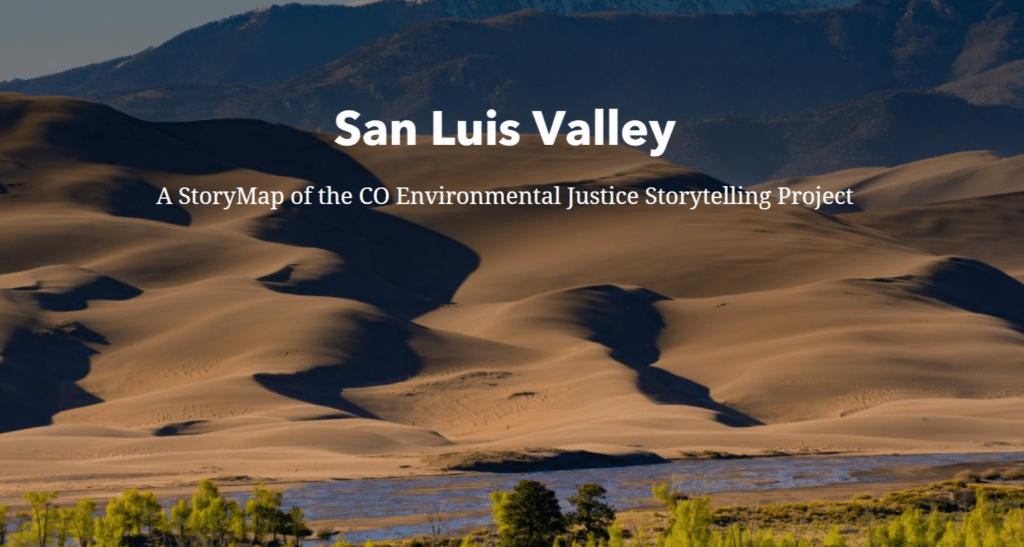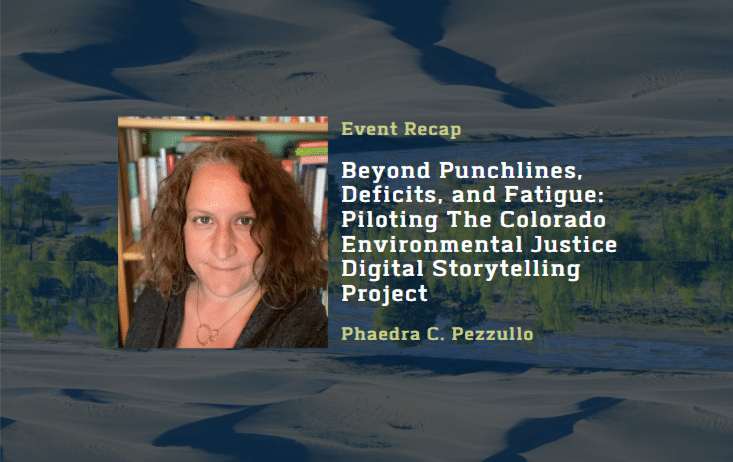In the latest installment of the Writing and Rhetoric Across Borders Speaker Series on April 12, the WRD Department welcomed Dr. Phaedra C. Pezzullo, scholar-activist, University of Colorado-Boulder professor, and Co-Director for the Center for Creative Climate Communication and Behavior Change and Just Transition Collaborative. Dr. Pezzullo’s presentation, “Beyond Punchlines, Deficit, and Fatigue: Piloting the Colorado Environmental Justice Digital Storytelling Project,” outlined her work sharing the stories of communities impacted by environmental harm across Colorado, demonstrating storytelling’s power to spark change.
Framing the Presentation: Environmental Racism and Environmental Justice
Opening with a land acknowledgement, Dr. Pezzullo shared her intention to ground the presentation in diverse perspectives, with particular consideration of Indigenous ways of knowing. She also acknowledged the environmental justice advocates–like Chicago’s Hazel M. Johnson and Cheryl Johnson–who have inspired her own work, before outlining her history in the environmental justice movement.
In this context informed by environmental justice, Dr. Pezzullo also defined “environmental racism,” a term that points to the ways BIPOC communities and individuals are targeted with disproportionate burdens of environmental harm. Sharing data from the EPA, she reiterated that “race, more than any factor, indicates a disproportionate burden” on communities impacted by environmental degradation across the United States.
However, as Dr. Pezzullo shared, “Data alone is insufficient for justice . . . we also have to use story, imagery, and other ways of moving publics to action.” Out of this need for mobilizing change through stories, the Colorado Environmental Justice Digital Storytelling Project began.
Piloting the Digital Storytelling Project
The Colorado Environmental Justice Digital Storytelling Project is an initiative created in 2022 by Dr. Pezzullo and her students, which they later published with the Colorado Department of Public Health and Environment.
Using the system ArcGIS, students created five StoryMaps to help audiences learn about fenceline communities impacted by environmental harm across Colorado. The StoryMaps combined visual rhetorical, stories, first-person audio clips, and other media to create a fuller picture of these fenceline communities, focusing not only on the environmental challenges they faced but, on their strengths, as well. According to Dr. Pezzullo, “lived experience brings a different way that information lands on people’s bodies and communities,” and one of the goals of the story maps was to share these lived experiences multi-modally to allow for this information to “land” on public audiences with a more personal impact than quantitative data often has.
“Our greatest natural resource is stories and storytelling. We have an endless, continuing, ongoing supply of stories.”
Leslie Marmon Siko, Laguna
Then, just months after they were created, these StoryMaps were included in the Colorado Resiliency Office’s Annual Progress Report 2022. Through collaboration with the Colorado Department of Public Health and Environment, the StoryMaps were published on state websites, not only widening their reach but also furthering accountability for the fenceline communities they highlighted.

One of the StoryMaps created for the Storytelling Project, featuring communities of the San Luis Valley.
Final Takeaways
In the field of rhetoric and composition, just as in others, scholars often focus on creating new research based on original ideas. Yet, Dr. Pezzullo emphasized that taking on the role of “curator” can be just as impactful. When it comes to storytelling projects like the Colorado Environmental Justice Digital Storytelling Project, artfully pulling together interviews, images, and ideas that have already been generated–even alongside new content–can have a powerful impact. This helps mitigate the fatigue of damage-centered frames, which force fenceline communities to share stories of harm over and over again. Additionally, it can help lawmakers and public audiences think about their relationship to impacted communities over ranges of time and in new ways.
Finally, Dr. Pezzullo ended the presentation with a hopeful invitation to scholars and students of writing and rhetoric to build empowering stories that utilize the range of media they have access to. “After all,” she shared, ““the only thing that maintains the status quo is doing nothing.”
